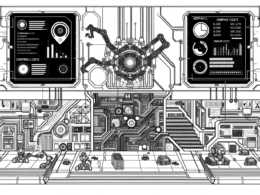In the relentless pursuit of more computing power, Taiwan Semiconductor Manufacturing Company (TSMC) is paving the way with its next level of System-on-Wafer (SoW) packaging technology, cheekily known as SoW-X. Aiming for the stars, or at least a spot in the biggest AI data centers, this push marks a major shift in how we think about processing power.
Here’s the lowdown
System-on-Wafer, as described by TSMC, is essentially a gigantic leap in chip packaging. Imagine your standard processor but on a gigantic silicon wafer — and not just a standard wafer, but a whole 300 mm one! This new SoW-X technology dramatically increases the size and capability of chip assemblies, making it ideal for AI data centers where space is at a premium.
TSMC’s first wave of SoW packaging involved simply integrating processing dies on a large substrate, which didn’t necessitate the entire wafer. The second generation, however, includes High Bandwidth Memory (HBM) chips directly on the wafer, eliminating complex RAM interconnects. This advancement effectively turns the wafer into a massive, singular functioning entity.
SoW-X can produce processors up to 17,000 W—enough to make AMD’s MI300X AI processors look diminutive. While they may not fit into your typical desktop build, TSMC’s SoW-X offers about 65% better performance-per-watt compared to traditional clusters.
These mega-processors won’t be in the mainstream tech marketplace anytime soon. The hefty costs mean only select clients, likely the largest tech companies dealing in AI and data crunching, will access SoW-X come 2027. Everyday tech will benefit indirectly as TSMC refines their methods and applies them to smaller-scale chip designs.
For now, CPUs and GPUs on your desk might not feel the impact directly, but the advances in SoW-X technology signal an impending shift. The technical know-how developed here will gradually trickle down, transforming smaller processors and making them more efficient.
Though we may not see them in our laptops, the knowledge TSMC develops through these cool behemoths will soon creep into standard consumer products, promising increased efficiency and power in smaller footprints. The future of processing power isn’t just in speed, but in size and the ability to compact powerhouse parts into efficient designs.









